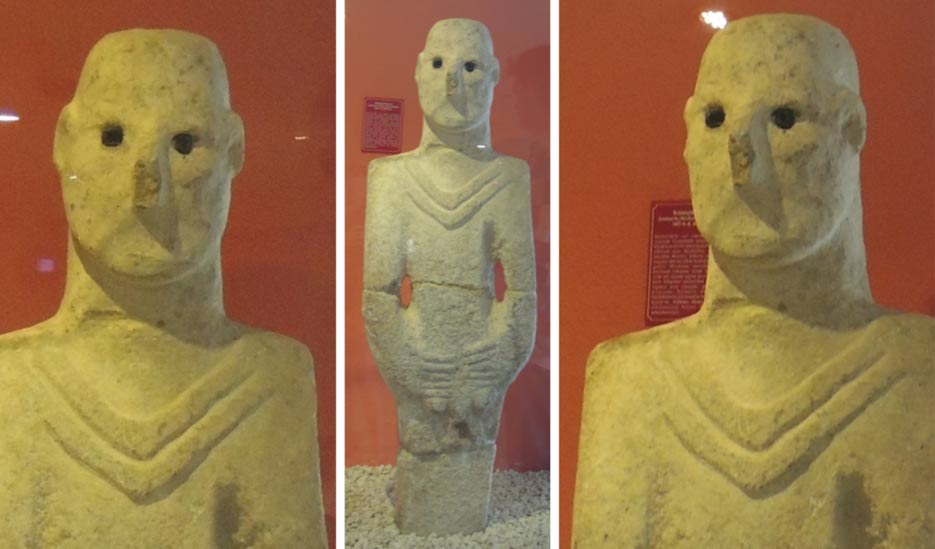I find these artifacts curious and really not covered much by either alternative or mainstream anthropology/archeology
For some reason I can't copy this page from this museum but its worth reading and the major discovery was done by Agatha Christie's husband
http://www.barbier-mueller.ch/collec...e-idol?lang=en
How it ties to Gobekli Tepe
Voices of the Dead: The Strange Origins of Eye Idols
Urfa man, known formally as the Balikligöl statue, is the oldest human-size statue of a man yet discovered in the world. He is currently housed in Şanliurfa’s Archeology Museum, Southeast Turkey. Urfa man was discovered in the Old Town section of Şanliurfa, but in antiquity belongs to the same thought world of Göbekli Tepe, a site half an hour away from the museum by car.
https://www.ancient-origins.net/arti...e-idols-002707
Eye idols are scattered over a vast region bounded by southeast Turkey (Arslantepe) to the north, Syria (Hama) to the west, and southern Mesopotamia (Telloh, Uruk, Ur) and Iranian Khuzistan (Susa) to the south. These objects are characteristic of the Proto-urban period in Uruk (3700-3100 BC) during which the first cities appeared. The many different contexts in which they were discovered (domestic, ritual, funerary, dumps) cast doubt on the strictly religious function of these objects, which vary greatly in shape, material, and style.
In 1996, Catherine Bréniquet suggested dividing the idols into three types. Type 1, from Tell Brak, known as "eye idols," covers all the small engraved alabaster plaques evoking the upper part of a human body with the face reduced to the eyes and sometimes adorned with jewelry and headdresses. Type 2, the "large idols with spectacles," covers quite large bell- or trumpet-shaped pottery objects with a neck supporting two perforated circles. Some have been carefully shaped, smoothed and glazed, while others are quite summarily made. Our idol belongs to this type of "large idols with spectacles," present in northern Mesopotamia and Syria. Type 3, which groups "small idols with spectacles" shows strong similarities with Type 2, but these objects are much smaller and are all made of stone.
https://www.louvre.fr/en/oeuvre-notices/eye-idol
I wish I could have done a better job on this post but my cheap chromebook is acting up. I don't think these were 'ancient alien' inspired but more of a
Beatles song....... ''I'm looking through you
I'm looking through you, where did you go
I thought I knew you, what did I know
You don't look different, but you have changed
I'm looking through you, you're not the same
- Home
- Forum
- Chat
- Donate
- What's New?
-
Site Links

-
Avalon Library

-
External Sites

- Solari Report | Catherine Austin Fitts
- The Wall Will Fall | Vanessa Beeley
- Unsafe Space | Keri Smith
- Giza Death Star | Joseph P. Farrell
- The Last American Vagabond
- Caitlin Johnstone
- John Pilger
- Voltaire Network
- Suspicious Observers
- Peak Prosperity | Chris Martenson
- Dark Journalist
- The Black Vault
- Global Research | Michael Chossudovsky
- Corbett Report
- Infowars
- Natural News
- Ice Age Farmer
- Dr. Joseph Mercola
- Childrens Health Defense
- Geoengineering Watch | Dane Wigington
- Truthstream Media
- Unlimited Hangout | Whitney Webb
- Wikileaks index
- Vaccine Impact
- Eva Bartlett (In Gaza blog)
- Scott Ritter
- Redacted (Natalie & Clayton Morris)
- Judging Freedom (Andrew Napolitano)
- Alexander Mercouris
- The Duran
- Simplicius The Thinker









 Reply With Quote
Reply With Quote
 ) and wearing very distinct "goggles" that were part of the helmet.
) and wearing very distinct "goggles" that were part of the helmet.

Bookmarks